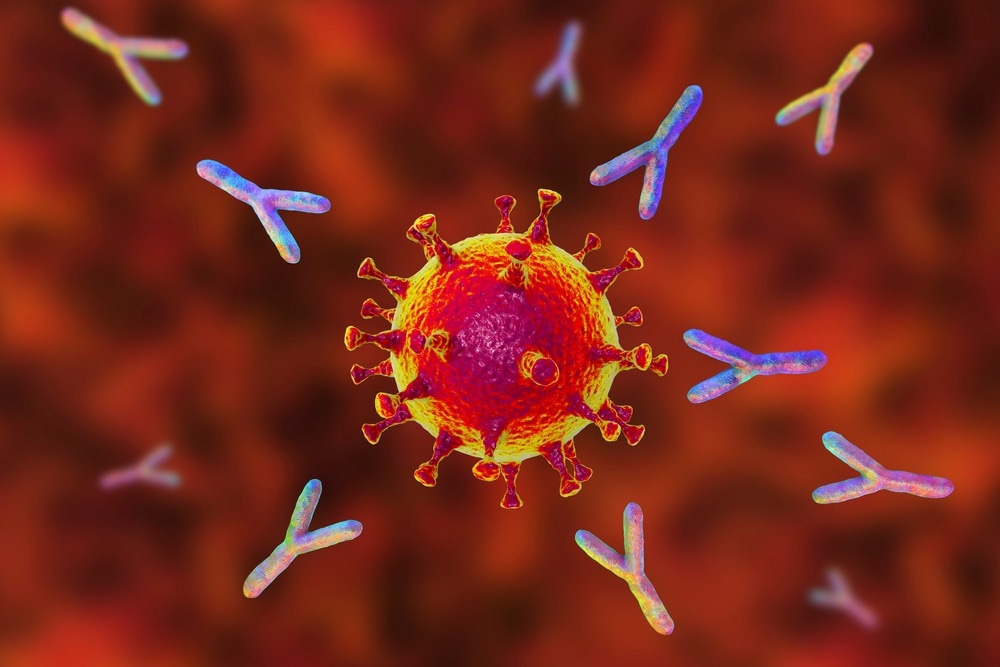In a recent study posted to the bioRxiv* preprint server, researchers screened the circulating B lymphocyte repertoires of coronavirus disease 2019 (COVID-19) convalescents and vaccinees using multiplexed antigen panels in a high-throughput single-cell workflow to isolate anti-severe acute respiratory syndrome coronavirus 2 (SARS-Cov-2) monoclonal Abs (mAbs).

Study: Deep repertoire mining uncovers ultra-broad coronavirus-neutralizing antibodies targeting multiple spike epitopes. Image Credit: KaterynaKon/Shutterstock.com

 *Important notice: bioRxiv publishes preliminary scientific reports that are not peer-reviewed and, therefore, should not be regarded as conclusive, guide clinical practice/health-related behavior, or treated as established information.
*Important notice: bioRxiv publishes preliminary scientific reports that are not peer-reviewed and, therefore, should not be regarded as conclusive, guide clinical practice/health-related behavior, or treated as established information.
Background
The emergence of novel, increasingly transmissible, and immune-evasive SARS-CoV-2 variants of concern (VOCs) has threatened the efficacy of COVID-19 vaccines and therapeutics, including monoclonal antibodies and antivirals.
Existing strategies target epitopes such as the spike (S) protein receptor-binding domain (RBD) and S protein subunit 2 (S2) of the ancestral strain. It is unclear whether the S N-terminal domain (NTD) can be targeted to develop effective Abs with wide neutralization breadth. Updated, next-generation vaccines encoding S proteins of different VOCs could improve vaccine efficacy and reduce the health burden of COVID-19.
In response to SARS-CoV-2 vaccination- and infection-induced immunity, several pathogens develop mechanisms to evade immune responses, concealing neutralizing regions or distracting the Ab responses with extremely immunogenic but non-neutralizing epitopes.
Potent and broad Abs are required to neutralize emerging SARS-CoV-2 VOCs, for which in-depth sampling of the anti-SARS-CoV-2 Ab repertoire is needed.
About the study
In the present study, researchers identified potent anti-SARS-CoV-2 Abs and provided \an expansive view of the anti-SARS-CoV-2 Ab repertoire.
The team performed multiplexed SARS-CoV-2 antigen screening with cellular immunological profiling technology, applied to a polymerase chain reaction (PCR)-confirmed COVID-19 convalescent and samples from SARS-CoV-2-positive individuals who contracted the infection in the initial COVID-19 period and received vaccines subsequently.
Peripheral blood mononuclear cells (PBMC) were obtained from the COVID-19 convalescent. Antigen-targeted B lymphocytes were enriched by flow cytometry, and a subset of 239 mAbs was selected for recombinant expression and in-depth characterization.
Live virus red dye uptake assays were performed to assess SARS-CoV-2 neutralization. In addition to S proteins from the SARS-CoV-2 Wuhan-Hu-1 strain, Beta and Gamma VOC, neutralizing Ab titers against SARS-CoV spike protein, and YN02 RBD were assessed. Further, epitope mapping and cryo-electronic microscopy (cryo-EM) were performed.
The team assessed protection conferred by CC24.2 and TXG-0078 against SARS-Cov-2 infection in vivo by administering 300.0 μg of the Abs independently and in combination, prophylactically, to 20 angiotensin-converting enzyme 2 (ACE2) transgenic mice.
Results
The findings indicated increased antibody breadth after vaccinating individuals with prior COVID-19 history. This is due to individual mAb broadening instead of being supplemented by complementary but narrow monoclonal Ab specificities.
Clonal coalescence between individuals was observed with sequences having similar germline rearrangements following similar maturation trajectories, indicating that Ab responses frequently converge independently on similar genetic solutions.
The team recovered two neutralizing mAbs of particular interest: (i) CC24.2, an anti-S RBD Ab, exhibiting pan-arbovirus breadth, including SARS-CoV-2 Omicron BA sub-VOC, BQ sub-VOC, and XBB sub-VOC, and (ii) TXG-0078, targeting the NTD epitope, using IGHV1-24, recognized several CoVs and β-CoVs, including 229E, HKU1, and OC43. TXG-0078 bound all SARS-CoV-2 isolates tested except Omicron and potently neutralized SARS-CoV-2.
TXG-0078 achieved remarkable binding breadth using the same VH1-24 variable gene signature and heavy chain-dominant binding pattern as other anti-NTD Abs with much lower specificity.
TXG-0078, independently or in combination with CC24.2, protected against SARS-CoV-2 infection in vivo when given as prophylaxis, and TXG-0078 conferred greater protection. Neutralizing anti-RBD monoclonal antibodies were more potent than anti-NTD neutralizing Abs.
From individuals with prior COVID-19 history and subsequent vaccinations, 6,302 paired mAbs were isolated, of which 58% were IgM. IgG titers markedly elevated with neutralization breadth (18% and 66%) in single-variant and pan-VoC binders, respectively. The findings indicated a relationship between increased maturation (somatic hypermutation and class-switching) and binding breadth.
CC24.2 Ab neutralized severe acute respiratory syndrome coronavirus (SARS-CoV) and several SARS-CoV-2 VOCs, such as Omicron VOC's BA.2 sub-VOC, BQ.1.1 sub-VOC, and the XBB.1.5 sub-VOC. CC24.2 and TXG-0078 functionally complemented each other almost perfectly.
TXG-0078 bound several CoVs but not SARS-CoV and Omicron, whereas CC24.2 did not exhibit neutralization potential beyond the sarbecoviruses tested but neutralized SARS-CoV and the Omicron sub-VOCs tested.
Mapping CC24.2 epitopes via competitive-type binding indicated a specificity overlapping two monoclonal Abs against a new RBD epitope called site 5.0.
TXG-0078 bound to NTD N3 and N5 loops using all three heavy chain complementarity determining region (HCDR) loops, and compared to the previously identified 4A8 anti-NTD Ab, TXG-0078 showed additional HCDR-3 interactions.
Conclusion
Overall, the study findings showed that a combination of CC24.2 and TXG-0078 protected against SARS-CoV-2 infection in vivo challenges and could be considered to widen the therapeutic landscape of COVID-19. Given the greater epitope diversity, antibody cocktails could be preferred to monotherapy and could also inform the development of universal COVID-19 vaccines.

 *Important notice: bioRxiv publishes preliminary scientific reports that are not peer-reviewed and, therefore, should not be regarded as conclusive, guide clinical practice/health-related behavior, or treated as established information.
*Important notice: bioRxiv publishes preliminary scientific reports that are not peer-reviewed and, therefore, should not be regarded as conclusive, guide clinical practice/health-related behavior, or treated as established information.